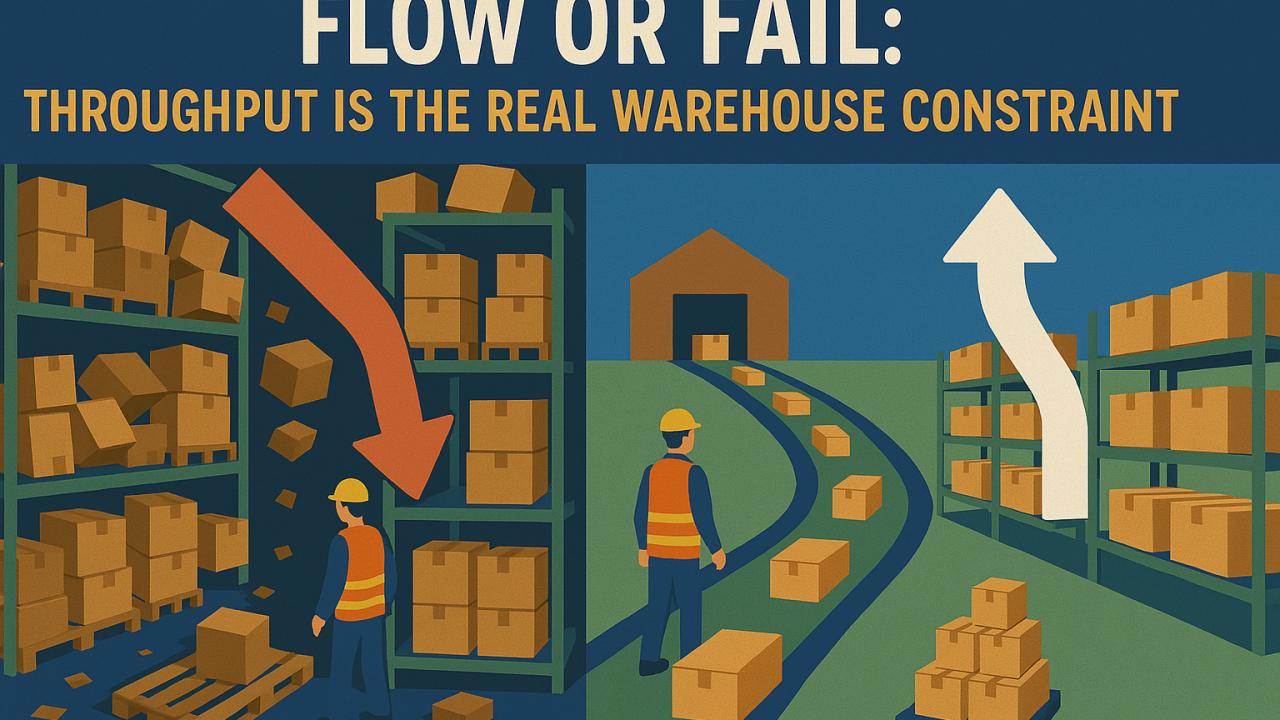Flow or Fail: Throughput Is the Real Warehouse Constraint
Warehouses across the country spent Q1 filling every available inch of space. Fueled by tariff uncertainty and the race to stay ahead of rising costs, inventory ballooned beyond normal levels. Pallets are stacked high, racking systems are stretched to capacity, and floor space is a luxury. Aisles that once allowed for smooth navigation have turned into narrow pathways, barely wide enough for a forklift to maneuver. Some facilities have even resorted to renting overflow storage, parking dozens of trailers in lots just to hold the excess. Sound familiar? The pressure was on—stock up now, or risk being caught short when prices spiked. But now that the inventory is here—what happens next?
The issue in Q2 isn’t space. It’s flow. The goods are in the building, but they’re not moving fast enough. Orders are piling up, and the backlog is growing. Customers are waiting, and every day of delay chips away at satisfaction—and profitability.
In 2025, the warehouse isn’t a storage vault—it’s a battlefield where flow determines survival. Are you ready to win?
The Constraint Has Moved: It's Not Space—It's Speed
The constraint has shifted, and savvy operators know it. It’s not about how much you can store anymore. It’s about how quickly you can turn. Throughput is the new metric that matters, and warehouses that can’t keep up are feeling the heat. Bottlenecks are forming at every stage—picking, packing, shipping. The once-efficient systems are now strained under the weight of overstocked shelves and understaffed teams.
And that’s where many warehouses are now hitting a wall. Labor shortages are biting hard, with hiring unable to keep pace with demand - a 2024 study by the National Association of Manufacturers found 68% of warehouse operators reported labor shortages as their top challenge, directly impacting throughput. The workers on hand are stretched thin, working overtime just to keep the operation afloat. But overtime costs are eating into margins, and fatigue is leading to mistakes—mis-picks, damaged goods, and delayed shipments.
Meanwhile, the supply chain isn’t slowing down to wait. Retailers are demanding faster delivery windows, and e-commerce giants are setting the bar higher every day. The rise of same-day delivery expectations, coupled with a 15% increase in e-commerce sales in 2024 (Statista), has made throughput a non-negotiable priority for warehouses aiming to stay competitive.
If goods don’t move out as fast as they come in, the whole system grinds to a halt. Warehouses that thrived in Q1 by stockpiling are now at risk of choking in Q2 if they can’t solve the flow problem. The question isn’t just about space anymore—it’s about speed, efficiency, and adaptability in a landscape that’s changing faster than ever.
Optimizing Flow: The Key to Unlocking Warehouse Efficiency
Flow is the heartbeat of any successful operation. But flow isn’t just a nice rhythm; it’s a measurable asset—a critical driver of performance that can make or break your bottom line. When materials, people, and information move through your facility smoothly, you reduce cycle time, increase throughput, and meet demand with confidence. Orders ship on time, customers stay happy, and your operation hums like a well-oiled machine. When they don’t, everything backs up: docks clog with unprocessed shipments, orders delay as backlogs grow, carriers miss their tight delivery windows, and labor becomes reactive instead of strategic. Workers scramble to fix problems rather than prevent them, and the ripple effects cascade—frustrated customers, strained relationships with carriers, and a hit to your reputation for reliability. In a world where speed and precision are non-negotiable, a lack of flow isn’t just an inconvenience; it’s a competitive disadvantage.
The biggest mistake leaders make right now is assuming this is a labor shortage problem—or worse, a space problem. That’s a false start, a misdiagnosis that leads to wasted resources and missed opportunities.
Throwing more bodies at the issue or leasing additional square footage might seem like a quick fix, but it doesn’t address the root cause. The real issue is that most warehouses are structured for volume, not velocity. They’re designed to store, not to flow. Racking systems are optimized for maximum capacity, not for quick access. Aisles are packed tight to hold more inventory, not to enable swift movement. And they’re staffed for predictability, not precision—built for steady, predictable workloads rather than the dynamic, ever-shifting demands of today’s market. This mismatch leaves operations vulnerable when demand spikes, orders surge, or unexpected bottlenecks emerge. Leaders who focus on headcount or space are fighting yesterday’s battle, while the real challenge lies in reimagining how their warehouse moves.
Which is why flow doesn’t improve with more headcount. It improves with flexibility. With real-time, tactical responsiveness to where the bottleneck is today—not where it was last month, or where it will be next quarter. Bottlenecks in a warehouse are fluid: one day, it’s a backlog at the picking station; the next, it’s a delay in loading trucks. A static workforce can’t keep up with that kind of variability. You need a labor model that adapts as quickly as the challenges do—one that lets you deploy workers exactly where they’re needed, exactly when they’re needed. That’s where on-demand labor comes in.
By tapping into a pool of skilled, vetted workers who can be mobilized within hours, you can address bottlenecks in real time, whether it’s adding hands to speed up order fulfillment or bringing in extra support for a last-minute shipment. This approach doesn’t just keep the operation moving—it transforms labor from a fixed cost into a strategic asset, giving you the agility to stay ahead of demand, reduce cycle times, and deliver with precision, no matter what the day throws at you.
Revolutionizing Operations: From Fixed Labor to Flex Labor for Enhanced Throughput
Veryable’s model isn’t about hiring more people to fill a warehouse with bodies, hoping that sheer numbers will solve the problem. It’s about empowering operations leaders with the precision and control to apply the right support, at the right point, at the right time—without the red tape of traditional hiring processes, the burden of fixed costs, or the delays that come with conventional staffing models. It’s about restoring the principle of takt time to labor planning: matching labor deployment to actual demand in real time, ensuring that every worker, every hour, and every task aligns perfectly with the rhythm of production. This isn’t a scattershot approach to staffing; it’s a strategic, data-driven method to optimize flow, reduce waste, and maximize efficiency. By focusing on real-time responsiveness, Veryable allows operations to move beyond the outdated mindset of overstaffing for worst-case scenarios and instead operate with the agility needed to thrive in today’s volatile market.
Because the truth is, throughput is no longer just an operations KPI buried in a monthly report—it’s a business strategy that defines winners and losers in the modern supply chain. The companies that flow win. They deliver on time, meet customer expectations, and keep their operations lean and agile, even in the face of unpredictable demand. The ones that don’t? They drown in their own inventory, trapped by overstocked shelves, delayed shipments, and frustrated customers. Excess inventory ties up capital, clogs warehouse space, and creates a domino effect of inefficiencies: missed delivery windows, increased storage costs, and a workforce that’s constantly playing catch-up. In a world where speed and precision are non-negotiable, failing to prioritize throughput isn’t just a missed opportunity—it’s a death sentence for competitiveness. The stakes are high, and the margin for error is razor-thin.
So the challenge before us in Q2 is not how to make room for more inventory, as many warehouses obsessed over in Q1. It’s how to move what we already have—faster, smarter, and leaner. The stockpiles are here, but they’re not generating value if they’re sitting stagnant. Every pallet that lingers in a warehouse is a missed sale, a delayed order, and a strain on cash flow. The focus must shift from accumulation to acceleration: getting goods out the door and into customers’ hands with minimal friction. This requires a fundamental rethinking of how we approach labor—not as a fixed resource to be hoarded, but as a dynamic asset to be deployed with precision. It’s about breaking free from the old-school mentality of “more is better” and embracing a leaner, more responsive model that prioritizes velocity over volume.
And that begins with a shift in mindset—from fixed labor to flexible, on-demand labor, from bulk planning to real-time deployment, from capacity as a constraint to capacity as a competitive edge. Fixed labor models, with their rigid headcounts and long-term commitments, are built for predictability, not adaptability. They assume a steady state of demand that rarely exists in today’s market, leaving warehouses overstaffed during lulls and understaffed during surges. Bulk planning, with its reliance on often inaccurate forecasts, forces operations leaders to guess at labor needs weeks or months in advance, leading to inefficiencies and wasted resources. In contrast, Veryable’s On-demand labor marketplace allows for real-time deployment, enabling operations to match labor to actual demand as it unfolds. This shift transforms capacity from a limiting factor into a strategic advantage, giving companies the ability to scale up for unexpected orders or scale down during quiet periods without incurring unnecessary costs.
Proof in the Flow: Real-World Wins with On-Demand Labor
The power of this approach is evident in Veryable’s work with distribution and warehousing companies facing similar challenges. For instance, In early 2022, Customized Distribution Services (CDS), a 3PL provider for Henkel and other major clients, faced a significant backlog of over 100 trailers in their Edwardsville facility yard, driven by a volatile labor market and supply chain instability. High overtime usage and reliance on inconsistent temp agency labor further strained their operations, risking delays in order fulfillment and customer dissatisfaction. By partnering with Veryable, CDS implemented an on-demand labor pool that allowed them to scale their workforce dynamically, reducing overtime and clearing the trailer backlog efficiently. This enabled CDS to restore flow in their distribution process, ensuring timely deliveries and maintaining service levels despite unpredictable demand, illustrating how failing to address labor constraints can halt operations, while flexible labor solutions can keep goods moving and prevent failure.
Core-Mark Tampa, a distribution facility, faced a critical challenge in early 2021 when sales volumes surged 27% higher than planned, straining their operations and risking late dispatches that could jeopardize customer satisfaction. With equipment constraints forcing longer operating hours and a labor shortage stretching their full-time staff thin, the facility turned to Veryable’s on-demand labor platform to build a flexible labor pool. This allowed them to quickly deploy additional workers, achieving a 10% improvement in on-time dispatches and a 15% reduction in overtime, ensuring goods moved efficiently through the warehouse. This case underscores the "flow or fail" premise, demonstrating that in a high-pressure distribution environment, the ability to scale labor in real time is essential to maintaining throughput and avoiding operational failure.
Goodwill Houston experienced higher-than-normal and unpredictable donation volumes, compounded by a volatile labor market during the pandemic. This created critical operational bottlenecks, with piles of donated goods waiting to be processed, leading to missed revenue opportunities and an overworked staff facing overtime and turnover. By partnering with Veryable, Goodwill Houston gained access to a flexible labor pool in the Houston area, allowing them to scale their workforce up or down at a moment’s notice. This on-demand labor model enabled them to process donations faster, increase productivity, and capture additional revenue without the costs of overstaffing or excessive overtime, ensuring their warehouse operations could keep up with fluctuating demand.
Gilster-Mary Lee Corporation (GML), a private label food manufacturer, faced significant operational bottlenecks at their rural McBride, MO, and Steeleville, IL distribution centers during their busy season in late 2022, with over 70 backlogged loads on the lot—well above their target of under 40. Operating in remote areas more than 50 miles from major metropolitan hubs, GML struggled with a limited local labor pool, particularly for certified forklift operators needed to handle palletized products, leading to extended lead times, employee overtime, and increased costs. By partnering with Veryable, GML accessed a flexible labor pool that allowed them to scale their workforce during peak demand from midsummer to late winter, clearing the backlog and improving throughput without overstaffing. This case exemplifies the "Flow or Fail" premise, showing how failing to address labor constraints in distribution can halt operations, while Veryable’s on-demand labor enabled GML to restore flow, meet customer service levels, and avoid operational failure in a challenging rural setting.
The End of Forecast-and-Hope: Leading with Labor Precision
The shift to on-demand labor also addresses the broader industry trend of demand volatility, which has been exacerbated by global supply chain disruptions, tariff uncertainties, and shifting consumer behaviors. Traditional labor models, with their long lead times and fixed commitments, are ill-equipped to handle these fluctuations. Veryable’s platform, however, provides a just-in-time workforce that can be mobilized within hours, allowing companies to tackle stranded orders, break work-in-process bubbles, recover from material delays, and eliminate past-due backlogs. As noted in our thought leadership blog, lead times can be reduced by up to 70% when on-demand labor is deployed to eliminate operational bottlenecks and supplement shifts. This capability is a game-changer for warehouses looking to turn inventory into revenue faster, ensuring they can meet customer demands without drowning in excess stock.
Ultimately, the transition is about more than just operational efficiency—it’s about redefining how warehouses compete in a fast-paced, demand-driven market. Companies that cling to outdated models risk being left behind, bogged down by inefficiencies, and unable to adapt to changing conditions. Those who embrace Veryable’s approach gain a competitive edge, turning capacity into a strategic weapon that drives throughput, reduces costs, and delights customers. The challenge in Q2 is clear: move what you have, faster, smarter, and leaner. And with Veryable, that challenge becomes an opportunity to flow, win, and thrive.
Tactical Playbook: Building Flow from the Floor Up
Improving flow isn’t about abstract ideas. It’s about daily actions. Here’s how operations leaders are using Veryable to tactically shift from volume to velocity inside the four walls of their warehouse:
1. Zone-Based Labor Deployment Break your warehouse into flow-critical zones: Receiving, Putaway, Replenishment, Picking, Packing, and Shipping. Use on-demand labor surgically. Identify today’s constraint—whether it’s a backlog at receiving or late orders in shipping—and deploy operators directly to that zone for a 4-hour or 8-hour support window. Think of it like pushing water through a pipe: focus on the blockage, not the reservoir.
2. Dock Flow Management Your dock is the pulse point of your operation. If trucks are waiting or backing up, you’re bleeding time and money. Use Veryable to deploy dock unloaders/lumpers during known peak hours. Schedule based on delivery appointments, not static shifts. Create a standing 6 AM – 10 AM and 3 PM – 7 PM dock unloading crew from your labor pool so your dock never becomes a choke point.
3. Rapid Replenishment Use on-demand labor to replenish pick zones faster. Delayed replenishment slows down pickers and drags your order cycle. When inventory is sitting in bulk and not flowing to pick faces, your system might show stock—but your pickers are walking empty aisles. Post a Veryable op to scan and restock pick faces in real time. No backlog, no excuses.
4. Micro-Batching Labor for Seasonal Orders When peak volume hits—promotions, events, or seasonal surges—don’t wait to bring on a new shift. Use Veryable to micro-batch labor. Break a 1,000-order day into three batches, and post labor to match each wave. This reduces fatigue, keeps the floor energized, and aligns your labor spend to output—not just hours. Pay operators in piecework to maximize speed – they’ll surprise you.
5. Audits and Inventory Correction Inventory accuracy is the foundation of flow. Use your bench of trained Veryable operators for cycle counts or bin audits. Instead of pulling your full-timers off core processes, add ops for weekend or overnight counts. If your WMS says bin A5 has 25 units, but the picker finds 3—your flow is broken before it starts.
6. Flow-First Layout Reset Have your internal team redesign for flow. Then use Veryable ops to do the heavy lifting. Moving racks, relabeling aisles, clearing out obsolete inventory—these are the hidden killers of throughput that linger for months without help. Assign a three-day layout reset crew from your labor pool to execute, without compromising daily ops.
7. Throughput KPIs, Not Time Clocks The only metric that matters is throughput. Not who showed up at 7:00, not who stayed until 5:00. With on-demand labor, you’re not managing people. You’re managing flow. Track pick rate, pack rate, dock turns, and putaway velocity. Post labor to match your constraints, not your schedule.
Precision Wins: Leading With Flow, Not Force in 2025
This is how operations leaders win in 2025—a year where adaptability and efficiency define success. They don’t try to do more with less, risking burnout and errors. They do exactly what’s needed—no more, no less—with speed, accuracy, and clarity that sets them apart. They create calm in the chaos by treating their warehouse as a living system of movement, where every element—materials, people, and data—flows seamlessly toward delivering value to customers with precision and reliability.
Every move is intentional, every decision grounded in purpose. Every post is surgical, placed with the care of a strategist who knows a single misstep can lead to delays. Flow becomes the measure, not just the goal—a key metric tracked daily to ensure operations run smoothly. They don’t waste motion or manpower on unnecessary tasks, nor do they fight volume with volume, adding bodies in a futile attempt to keep up. Instead, they apply labor like pressure to a lever—calculated, focused, and leveraged to maximize impact with minimal effort, ensuring resources are used where they matter most.
And they achieve this by turning their warehouse into a system of responsive flow, powered by the right labor, in the right place, at the right time. This isn’t about overstaffing or understaffing—it’s about dynamic alignment—matching workforce to demand in real-time. It’s not staffing in the traditional sense—it’s strategy, a deliberate approach to labor deployment that drives efficiency. You don’t need more people to win; you need more flow. And flow is earned—one precise, tactical decision at a time, each building a system that moves faster, smarter, and more effectively than the competition.
Ready to transform your warehouse into a system of responsive flow? Contact us or create your free business profile to get started.
Previous Posts
Hidden Inefficiencies in American Manufacturing and How that Impacts Capacity & Consumer Prices
The Future of Manufacturing and Logistics
Create a free business profile today to explore our platform.






